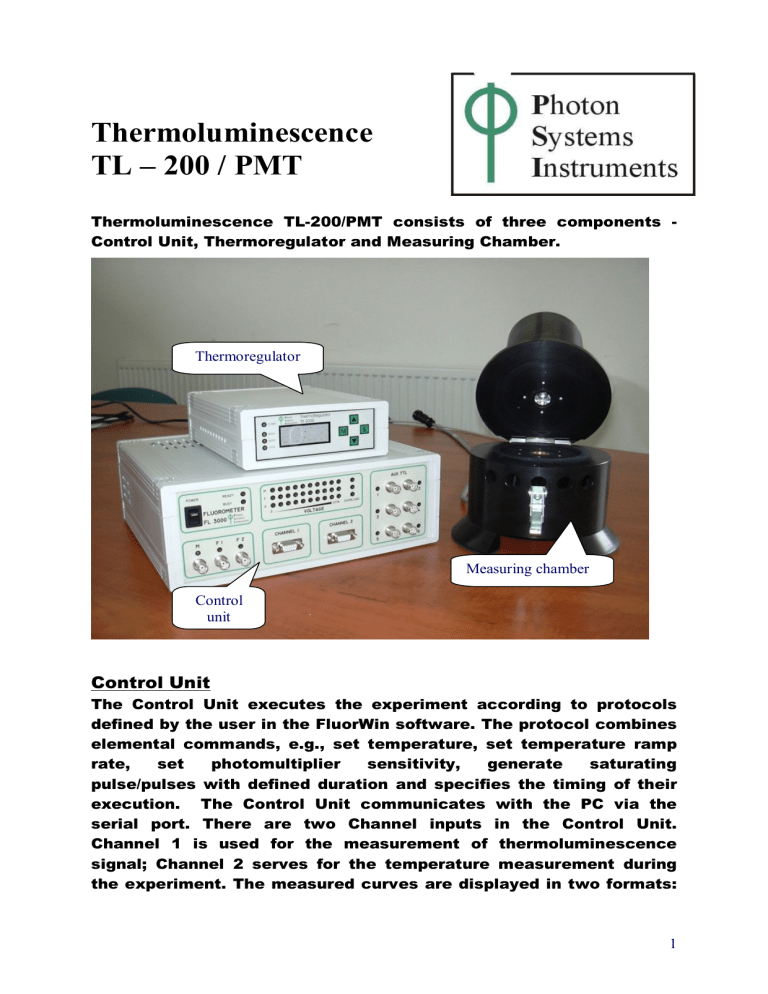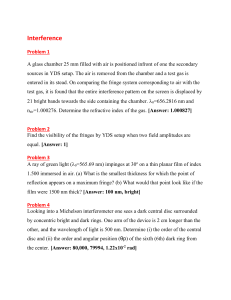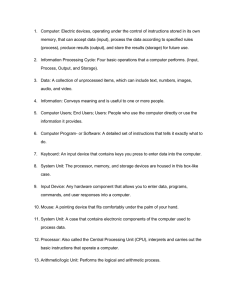Thermoluminescence TL – 200 / PMT

Thermoluminescence
TL – 200 / PMT
Thermoluminescence TL-200/PMT consists of three components -
Control Unit, Thermoregulator and Measuring Chamber.
Thermoregulator
Control unit
Measuring chamber
Control Unit
The Control Unit executes the experiment according to protocols defined by the user in the FluorWin software. The protocol combines elemental commands, e.g., set temperature, set temperature ramp rate, set photomultiplier sensitivity, generate saturating pulse/pulses with defined duration and specifies the timing of their execution. The Control Unit communicates with the PC via the serial port. There are two Channel inputs in the Control Unit.
Channel 1 is used for the measurement of thermoluminescence signal; Channel 2 serves for the temperature measurement during the experiment. The measured curves are displayed in two formats:
1
Time/Temperature and Time/TL Signal, or Temperature/TL Signal. It is also possible to export the measured data to a *.txt file for an analysis in other software packages.
Temperature
TL signal time
TL signal temperature
Thermoregulator
The Thermoregulator controls the temperature of the sample disc in the range of -25°C to +70°C. The temperature can be set either manually or by the protocol (software). The actual temperature of the sample is displayed on the front panel of the Thermoregulator.
The temperature is read and recorded by the Control Unit. In the temperature ramp mode, the Thermoregulator increases the temperature of the sample linearly with a rate ranging between
0.1°C/sec - 2°C/sec.
Measuring
Chamber
The Measuring
Chamber consists of four key parts:
A/ Light source
The light flashes are emitted by a ring of 8 powerful Lumiled diodes ( λ max
=630nm) focused on the sample disc. The intensity of a single turnover flash is
Detector
LED
2
around 200 000 µmol(photons).m
-2 .s
-1 . The maximum flash duration is 150 µs. The light intensity as well as the flash duration are software controlled.
B/ Photomultiplier with an integrated power supply
The photomultiplier detects photons in the wavelength range 300-
900nm. A switch shuts the photomultiplier down when the measuring chamber opens so that the photomultiplier is protected from high ambient light. After the light flash the photomultiplier is switched on in 100 ms so that only delayed luminescence is detected.
C/ A/D converter
The electric current of the photomultiplier is amplified with a software controlled gain before digitization. The time response of the amplifier is fixed at 50ms, determining minimal sampling period to 100ms. The signal is digitalized directly in the measuring chamber.
D/ Sample disc with the cooling unit
Gold-plated copper
½
” Sample disc
The sample disc is made of gold-plated copper. The temperature sensor is situated right under the surface of the disc. The sensor is calibrated in the range of -25°C to
+70°C with an accuracy of ±0.2°C.
Suspensions of cells, chloroplasts or membranes ought to be measured on a filtration paper (12.7mm, 1/2inch in diameter) so that good thermal connection between the metal disc surface and the sample is maintained. The sample volume should be as low as possible
(<100 µ l) to minimize its heat capacity.
Built-in Peltier cell is responsible for cooling and heating of the sample disc. For operation between +10°C to +70°C, the Peltier cell is sufficiently cooled by the built-in fan. For temperatures lower than
3
+10°C an outer cooling water-circuit is required. The water source provided by the user is connected to two silicon hoses of the measuring chamber. For the highest cooling rate the water temperature should be optimally around +4°C. This allows that the cooling time from +20°C to -10°C is as short as 50 seconds. With tap water temperature between 15-20°C the cooling time increases to ca
70s.
Water pump
WARNINGS:
1) The Thermoluminescence TL – 200/PMT can also measure leaf segments. In this case, the dynamic thermal equilibrium between the sample metal disk and the leaf is harder to maintain and the thermometer reading must be calibrated by the user for the particular experimental setting.
2) The user also has to consider potential temperature-reading errors that can be caused by the phase change in the sample
(freezing, de-freezing). Because of the latent heat, the sample is arrested during the phase change at a constant temperature (the temperature rise is non-linear). This error will be small if the sample volume is low.
4
Technical specification :
Temperature control:
Temperature range
Modes of operation
Overheating protection
Sampling period
Control regimes
Sample:
Sample diameter
Sample disc material
Typical sample
Light source wavelength
Light source intensity
Detection system:
Sensor
Spectral response
Sampling period
Time response
Switch-on delay
Ambient light protection
A/D converter resolution
Control unit:
Custom defined protocols
Communication
Software
Electrical
-25°C - +70°C with water circuit
+10°C - +70°C without water circuit constant; linear change (0.1°C/sec – 2°C/sec)
80°C
10ms manual (constant temperature), protocol defined temperature profiles
½
” disc
Gold-plated copper algae, cyanobacteria on
½
” filtration paper
λ max=630nm up to 200 000 µmol(photons).m
-2
.s
-1
Photomultiplier with sensitivity control (software)
300nm-900nm
100ms
50ms
100ms mechanical switch
16bit
Variable timing, special language and scripts
Serial port
FluorWin 3.6
90V-240V
5





